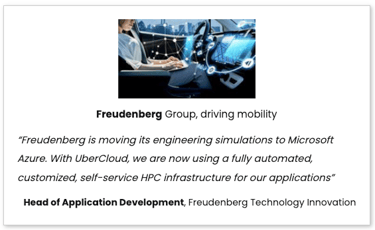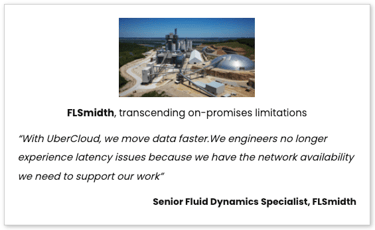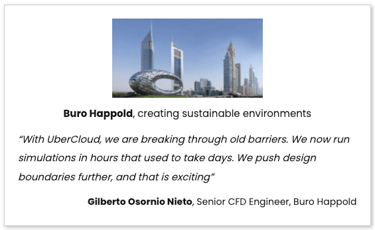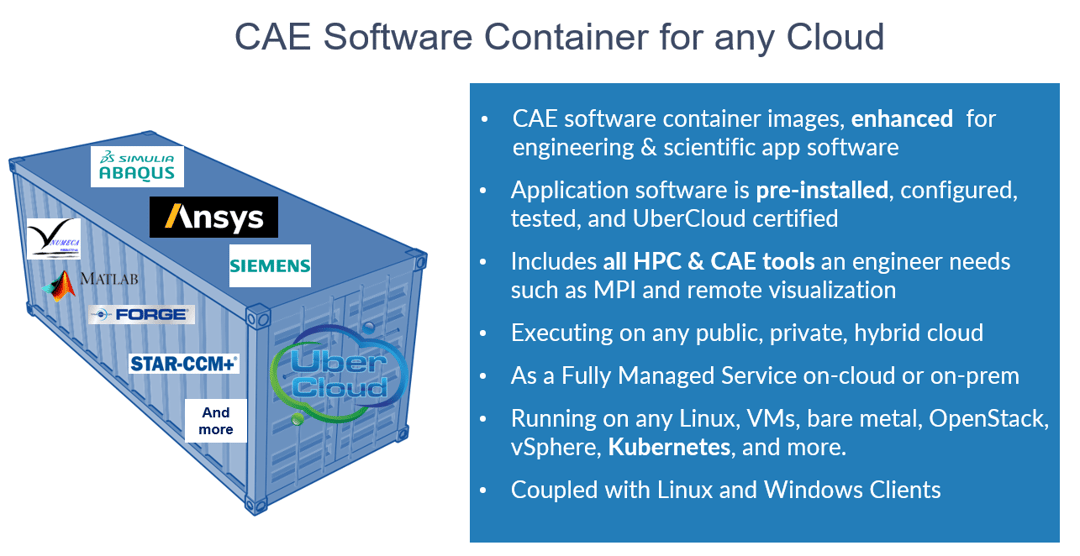This blog summarizes major challenges of today’s on-premise engineering simulation environments, and it offers solutions and benefits that are important for companies and their stakeholders (CEO, CIO, CTO, VPs, and Directors) in manufacturing, automotive, aerospace, life sciences, and energy.
At the top of company’s agenda today are important business goals such as increasing productivity, improved product quality, rapid product innovation and return on investment, improving the company's competitiveness in today's global marketplace.
There are many excellent articles on how to plan and achieve these strategic goals in prestigious journals such as Harvard Business Review, MIT Technology Review, and Sloan Management Review, which is not necessary to duplicate here. Instead, our focus here is a specific but very important area where UberCloud can serve as a highly effective lever for decision makers in their journey towards achieving these goals. This is about increasing engineering productivity when designing and simulating the company's products.
For many years, organizations have suffered from the high costs associated with sophisticated engineering designs and simulations of the company's next-generation products. These costs are related to several factors, including the high capital expenditures for expensive computer hardware and simulation software, the annual maintenance and operation of the High Performance Computing (HPC) infrastructure, data center space and electricity, a team of HPC/IT professionals to maintain this computing environment and the simulation support engineers to name but a few. In addition, on-premises computing resources are limited in capacity and performance on high demand use days, while on other days they may be close to idle, resulting in wasted investments.


But how does one increase engineering productivity when designing and simulating the company's next-generation products, while simultaneously reducing the various cost drivers mentioned above? The answer is, by allowing engineers to develop many more product designs with many more parameters for different materials, geometries, physics, etc., resulting in better product quality in less time, more effective innovation, quickly and cost-effectively.
Our goal is to empower engineers with user-friendly access (at the touch of a button) to many more computational resources to achieve increasingly accurate and higher-quality design results in less time. Our customers have realized that having 10x more computing resources have allowed engineers to deliver 10x more simulations and increased their productivity by a factor of 10.
In addition to a 10X increase in productivity, engineers can dramatically improve the quality of their next-generation product designs, helping their organization be more competitive and innovative, and providing faster time to market in today's global marketplace.


So, what is the solution that allows engineers to be so dramatically more productive? The answer is quite simple: using a lot more computing resources for their designs when it is needed, and at the right time. Such massive amounts of computing resources are available in today's HPC clouds from hyperscalers like AWS, Azure, Google and Oracle.
But implementing such a solution in the cloud is by no means trivial. A Do-It-Yourself (DIY) solution is very time consuming and has a high risk of failure, as you will need multi-talented experts who understand HPC, CAE and cloud at the same time. The same issues apply to the hyperscalers' excellent but limited professional services teams, who simply do not have the necessary time to build individual cloud solutions satisfactorily for each customer, especially when it comes to complex simulation workflows such as multi-physics, digital twins, machine learning and more. Another alternative might be to use some of the CAE software vendors' single solver clouds, but that can be a dead end as it only works for a single-solver simulation and only for that particular software vendor's solvers. You will not have exclusive control over your valuable company resources as they are hosted in the software provider's cloud tenant. The same issues apply to providers of HPC/CAE cloud services that offer a browser, portal or appliance based service that is hosted in that provider's cloud tenant.
Of course, there is some good news! There is one cloud solution stack that doesn't come with these obstacles, it is the automated and self-service UberCloud Engineering Simulation Platform. Its unique HPC application software containers that host the engineer's complex (and probably custom) simulation workflow and provide instant one-button access and utilization of all cloud resources, with an identical look and feel and with no learning needed. Platform and containers run on demand on flexible start-scale-stop HPC resources on a single tenant in the company's own cloud account, under the exclusive control of the engineers and their company.
In summary, some of the major benefits of the UberCloud Engineering Simulation Platform are:
For Decision Makers:
- Shorten time to market, improve product quality, save costs, increase ROI
- Strengthening your company’s competitiveness and ability to innovate fast
- Integrate HPC as part of your corporate digital transformation, no more silos
For IT Leaders:
- Avoid “Do It Yourself” and overcome lack of Cloud/HPC/CAE expertise
- IT-tools to manage, monitor, health-check, maintain, and thus control the cloud
- Continuously update cloud resources, services, support, and maintenance
For Engineering Leaders:
- Automated flexible latest HPC as a Service with exclusive control (no 3rd party control)
- User friendly: "Cloud with one click“ and “no learning needed” virtual desktop
- 10X and more increase in productivity of your simulation engineers
Appendix
For more details about UberCloud's technology that enables all these benefits for decision makers, IT, and Engineering, please see the following diagrams about our automated, self-service UberCloud Engineering Simulation Platform and the unique UberCloud engineering application workflow containers.


-1.png?width=1080&height=622&name=image%20(5)-1.png)

